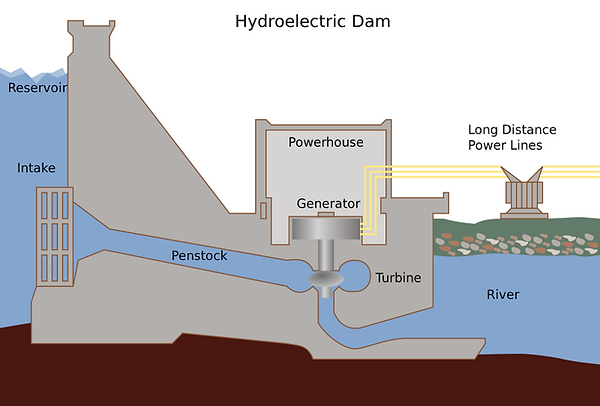Hydropower
a brief introduction to hydro-electric power
Overview:
Hydropower is a renewable energy source that harnesses the power of flowing water to generate electricity. The process involves the use of a dam to create a reservoir or pond, where water is stored. When water is released from the reservoir, it flows through a turbine, which spins a generator to produce electricity. The amount of electricity generated depends on the amount of water flowing through the turbine, the height of the dam, and the efficiency of the generator.
Hydropower plants can be divided into two main types: run-of-the-river and storage. Run-of-the-river systems use the natural flow of a river or stream to generate electricity, without the need for a dam or reservoir. Instead, water is diverted through a channel, or penstock, that leads to the turbine. Storage systems, on the other hand, use a dam to store water in a reservoir, which can be released as needed to generate electricity. These systems can also incorporate a pump to move water from a lower reservoir to a higher one during periods of low demand, so that it can be released later to generate electricity when demand is high.

Environmental impacts?
The construction of hydropower plants and associated infrastructure can have significant environmental impacts, particularly if not planned and managed carefully. Here are some ways:
-
Alteration of river flow: Building a dam and reservoir on a river can alter the natural flow of water, which can have downstream impacts. Changes in flow can affect the habitats of aquatic species and disrupt the balance of ecosystems.
-
Habitat loss: The construction of a dam and reservoir can result in the loss of natural habitats for plant and animal species. This can have cascading effects throughout the food chain, leading to declines in populations of species that rely on these habitats.
-
Displacement of communities: The construction of a hydropower plant can require the displacement of local communities, particularly if their homes or livelihoods are located in the area that will be flooded by the reservoir.
-
Sedimentation: The reservoir behind a dam can trap sediment that would naturally flow downstream. This can impact the health of aquatic ecosystems and reduce the lifespan of the reservoir itself.
-
Methane emissions: Decomposing organic matter in the flooded area behind a dam can release methane, a potent greenhouse gas, into the atmosphere.
Compared to other energy sources?
Comparison of advantages and disadvantages:
-
Renewable and reliable: Hydropower is a renewable energy source that can provide a reliable source of electricity, with the ability to generate power around the clock. In comparison, solar and wind power can be variable depending on weather conditions.
-
Low emissions: Hydropower does not produce greenhouse gas emissions or other pollutants associated with fossil fuel combustion, making it a cleaner energy source than coal, oil, and natural gas.
-
High capital costs: Building a hydropower plant can be expensive, particularly for larger projects. The cost of constructing a dam and reservoir, installing turbines and generators, and building transmission lines to connect the power to the grid can be substantial.
-
Environmental impacts: As mentioned earlier, the construction of hydropower plants and associated infrastructure can have significant environmental impacts, particularly if not planned and managed carefully. Other forms of renewable energy, such as solar and wind, have lower environmental impacts.
-
Land use: Hydropower plants require a large amount of land for the reservoir and associated infrastructure, which can impact local communities and wildlife habitats. In comparison, solar panels and wind turbines can be installed on smaller areas of land.
Economic competitiveness?
The economics of hydropower can vary depending on several factors, such as the location and size of the project, the cost of construction, and the cost of other energy sources. In some cases, hydropower can be economically competitive with other energy sources, while in others, it may be more expensive.
Once a plant is built, the cost of generating electricity is relatively low, as water is a free and abundant resource. This can make it a cost-effective energy source in regions with abundant water resources and high energy demand.
However, the cost of building a hydropower plant can be high, particularly for large projects. The cost of constructing a dam and reservoir, installing turbines and generators, and building transmission lines to connect the power to the grid can be substantial. In addition, hydropower plants may require ongoing maintenance and repair costs.
In comparison to other forms of renewable energy, such as solar and wind, hydropower has a relatively high levelized cost of electricity (LCOE), which takes into account the total cost of building and operating a power plant over its lifetime, as well as the amount of electricity generated. However, the LCOE of hydropower can be competitive with fossil fuel sources, particularly if the cost of emitting carbon dioxide and other pollutants is factored in.